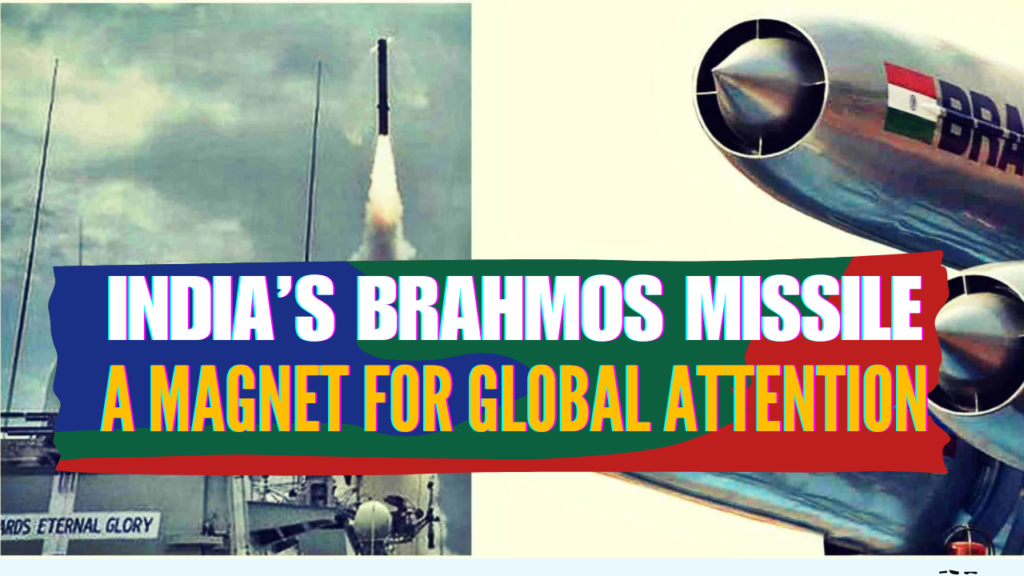India’s BrahMos Missile: A Magnet for Global Attention
India is ready to deliver BrahMos supersonic cruise missiles to the Philippines, with other nations, including those in West Asia and Africa, reportedly expressing interest in acquiring BrahMos. Let’s delve into the trajectory of these weapons and explore what sets them apart. There is a growing global demand for India’s BrahMos missile. While the supersonic cruise missiles are scheduled for delivery to the Philippines by March, BrahMos Aerospace, a joint venture between India and Russia, is reportedly in negotiations to supply BrahMos missiles to Saudi Arabia. According to a report by the Economic Times (ET), Indonesian President-elect Prabowo Subianto has expressed interest in procuring BrahMos missiles. Additionally, New Delhi has offered BrahMos cruise missiles and other defense equipment to Vietnam. India has set an ambitious target of achieving defense exports worth ₹35,000 crore by 2025, and the sale of BrahMos missiles could significantly contribute to this goal. As countries show interest in acquiring BrahMos missiles, let’s trace the remarkable journey of these supersonic cruise missiles. The Origin of the BrahMos Missile In the early 1990s, India recognized the strategic importance of cruise missiles, which are guided missiles capable of delivering precision strikes while traveling at nearly constant speeds over most of their flight path. Following the deployment of cruise missiles during the Gulf War, India realized the necessity of possessing a cruise missile system. This led to the signing of an Inter-Governmental Agreement in February 1998 between Dr. APJ Abdul Kalam, then Chief of the Defence Research and Development Organisation (DRDO), and NV Mikhailov, then Russian Deputy Defence Minister, in Moscow. The name “BrahMos” is derived from the Brahmaputra and Moskva rivers. The 1998 agreement paved the way for the establishment of BrahMos Aerospace, a joint venture between DRDO and NPO Mashinostroyenia (NPOM), aimed at designing, developing, and manufacturing the supersonic cruise missile system. On June 12, 2001, the BrahMos missile underwent its first test launch from a land-based launcher at the Integrated Test Range (ITR). Since then, the missile has undergone multiple upgrades, with various versions being developed and launched. Features of the BrahMos Missile According to the BrahMos Aerospace website, BrahMos is a two-stage missile with a solid propellant booster as its first stage and a liquid ramjet as the second stage. BrahMos is classified as a “standoff range weapon,” meaning it can be fired from a distance that minimizes the risk of interception by the adversary’s defenses. The original flight range of BrahMos was 290 km, but versions of the missile with extended ranges, including up to 400 km and beyond, are being tested. The missile boasts a low radar signature and maintains high supersonic speeds throughout its flight. It is a “fire and forget” type of missile capable of reaching cruising altitudes of up to 15 km and terminal altitudes as low as 10 meters. Compared to subsonic cruise missiles, BrahMos offers three times the speed and 2.5 times the flight range. Various versions of the BrahMos missile, designed for launch from land, warships, submarines, and Sukhoi-30 fighter jets, have already been developed. These versatile projectiles can effectively target both surface and sea-based threats. In November, the Indian Navy successfully test-fired an extended-range BrahMos missile from a warship in the Bay of Bengal. The projectile, launched from a stealth destroyer by the eastern fleet, precisely hit its target, paving the way for its induction into the Indian Navy. What Makes BrahMos Special? The BrahMos missile has garnered significant attention in international markets, particularly in Southeast Asia and Africa, with several countries in West Asia also expressing interest in acquiring it. Indian Navy veteran Seshadri Vasan described BrahMos as the world’s “Supersonic Darling,” highlighting its ability to rapidly engage targets once it enters supersonic mode at Mach-3 speed, leaving little time for the enemy to respond. According to Pravin Pathak, BrahMos Aerospace’s export director, the portfolio of orders for BrahMos missiles has already reached $7 billion, encompassing both Indian and export orders. Senior DRDO scientists emphasize the precision and versatility of the BrahMos missile system, highlighting its unmatched capabilities. Retired DRDO scientist Ravi Gupta emphasized that the BrahMos missile’s features provide a significant edge to the armed forces that possess it, while also noting its cost-effectiveness compared to similar missiles produced in other countries. As India endeavors to bolster its defense exports, BrahMos missiles emerge as a potent asset that can significantly contribute to achieving its objectives and enhancing its strategic partnerships globally.

